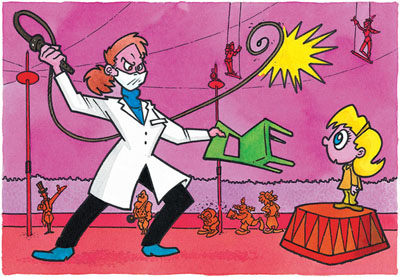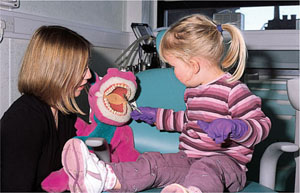Chapter 5
Behavioural Management Techniques
Aim
The aim of this chapter is to present the common behavioural management techniques that the dental team can use to deliver care successfully to children (Fig 5-1).

Fig 5-1 Use behavioural management to tame children!
Outcome
On completing this chapter you should be able to undertake, either alone or in combination, a number of behavioural management strategies and identify which are the most suitable for individual patients.
Introduction
The label “uncooperative” is frequently applied to a child who behaves poorly in the dental surgery. Occasionally the term is used after his or her first visit. The term implies that a child is deliberately being awkward, but this is not usually true. Their behaviour normally reflects how they are feeling. We need to remember that, unlike adults, a child has no choice when attending the dentist: a grown-up brings them. Children have relatively limited communication skills and are less able to express their fears and anxieties verbally. When a child cannot cope, they attempts to “escape” and the change in behaviour that you see in the dental chair is often a child who is anxious or uncomfortable and has no other way to cope or inform you of their difficulty. Behaviour-management strategies try to help children accept the various feelings and experiences associated with dental treatment.
Behavioural Management
Graeme Wright (1975) defined behavioural management as “the means by which the dental health team effectively and efficiently performs treatment for a child”. He suggests that a “positive dental attitude” is the aim of behavioural management. More recently he has refined the definition so as not to imply just behaviour necessary to complete a given task, but to include creating a long-term interest on the patient’s part for ongoing prevention and for future improved dental health. To do this the dentist must establish relationships based on trust with the child and accompanying adult to ensure compliance with preventive regimes and allow treatment to occur (the “treatment alliance”) (Fig 5-2).
-
Behavioural management methods are about communication and education.
-
The relationship between a child, the child’s family and the dental team is a dynamic process that is the key to success.
-
Behavioural management starts before the patient arrives in the surgery and employs dialogue, voice tone, facial expression and touch.
-
No single method will be applicable in all situations. Instead, the appropriate management technique(s) should be chosen based on the individual child’s requirements.

Fig 5-2 A happy and memorable first visit to the dentist.
Behavioural management techniques
“Tell-Show-Do”
“Tell-Show-Do” is a technique used widely to familiarise a patient with a new procedure. It employs concepts from learning theory and has been adopted by many paediatric dentists. The technique works well combined with behaviour shaping and is well accepted by parents, although there is little research relating to its use. It appears to be most valuable with low-anxiety levels: there is no evidence to support its usefulness with very anxious children. More recently it has been shown to reduce anticipatory anxiety in new child patients, although it was less useful in children with previous negative dental experiences (Fig 5-3).

Fig 5-3 Acclimatisation.
The tell phase involves an age-appropriate explanation of the procedure. The show phase is used to demonstrate the procedure – for example, demonstrating with a slow handpiece on a finger. The do phase is initiated with minimum delay – in this case a polish. The language used must be appropriate to the child’s age – many dentists use a personal version of this “childrenese” (Table 2-1) and the whole dental team must adopt the same approach. Specifically emotive or negative words are avoided.
Behaviour-shaping and positive reinforcement
Many dental procedures require quite complex behaviours and actions from our patients. Adults have learnt that they come into the dental surgery, lie down and have their teeth examined. They understand that they need to be quiet and to allow the dentist to look at their teeth. A child patient does not know what is expected of them and the dental team needs to teach them how to behave. For children this requires small, clear steps. This process is termed “behaviour shaping”. It consists of a defined series of steps towards ideal behaviour. This is most easily achieved by selective reinforcement.
Reinforcement is the strengthening of a pattern of behaviour, increasing the probability of that behaviour being displayed again in the future. Anything that the child finds pleasant or gratifying can act as positive reinforcement. Stickers or badges are often used at the end of a successful appointment. However, the most powerful reinforcements are social stimuli – such as, facial expression, positive voice modulation, verbal praise and approval through hugging. A child-centred, empathic response giving constant feedback and specific praise (for example, “I like the way you keep your mouth open”) has been shown to be more effective than a general comment such as “Good girl.” As with “Tell-Show-Do”, the use of age-specific language is imperative.
Stay updated, free dental videos. Join our Telegram channel

VIDEdental - Online dental courses


